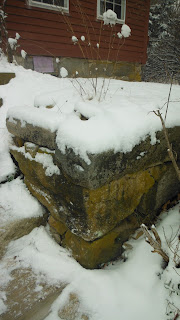There is some Native
American “expedient imagery” (Jack Steinbring’s term for some stones that may
have been at least minimally enhanced to more resemble an animal or human) in
these stones – and what you see all depends on light conditions, along with
some open mindedness. I have walked up these steps many times over the last 35
years but I am only just beginning to see what is there in those stones, most
likely shaped and modified before finally being placed just as they are. And
I’m glad it has taken so long for me to get to these steps in the restoration
process, glad I didn’t give a go ahead to a stone mason or two (or three) who
wanted to take it all apart and rebuild it all. That’s the “business” of stone
wall construction and not the conservation of a unique stone structure that is
about 300 years old.
I also had to walk
thousands of miles of stone walls, unlearning everything I’d learned about
stone walls in the first half of my life and begin to make my own sort of field
guide to Indigenous Stone Walls, unlearn as well the Pristine
Wilderness Myth the Puritans created and actually learn to see the Indigenous
Cultural Landscape that underlies the modern landscape.
And start to
realize that this is a pattern of Indigenous Stonework, a sideways looking
Great Serpent – an Uktena or “Strong Looker” who knows the thoughts of the
person just by looking at them:
And actually it is two Serpents at this gate –
on the property of the first Puritan minister in a nearby town, more likely an
Indigenous construction than not, two Great Serpents guarding an enclosed section of an indigenous domesticated
landscape (not a stone fence but a Qusukqaniyutôk: ‘stone row, enclosure’ ‘fence that crosses
back’ and variations such as Qussukquanentunk -
(PEA)(singular)(recovered): a stone wall - a Quisenkquannútonk: (collquial) (archaic)
(unattested)(singular): a stone wall), than a colonial construction that resembles a symbol of a famous
fallen angel who encouraged Eve to take a bite of that apple from that Tree of Wisdom.
Build a snake for the
Puritan Preacher’s farm and you’ll probably find out more about a witch trial
than you really care to. These Serpent "Stone Walls," these "Snake Rows of Stones," this Serpent Gateway, was
probably already existing in 1740 when the Preacher showed up in the former "Wilderness," possibly wooden rails added to it maybe to make it a four and a half foot tall legal fence according to early CT Property Laws. Before that, maybe there were
some other enhancements to the Stone Snake Head features at this gate, perhaps
antlers since various forms of representations of this the spirit being are
portrayed as having horns (with other variations as well):
So, here at
home, walking up our front steps one day, the light hit this capstone just
right and I saw that perhaps this stone had been modified and was placed as it
was in order to resemble a snake or perhaps Great Serpent:
Note the possible
turtle-like arraignment or placement of stones (and ignore that capstone I moved and placed on the adjacent one, above) , two forelegs extended on both
sides of head pointed in the same direction, with a similar enhanced eye, the
same curve to the upper lid. Above these “turtle parts” is a marble-like flat
carapace and smaller capstone:
(And there's a possible human-like face profile, nose at about 1:00.)
Sunrise, Vernal Equinox 2016, as seen from front doorway:














Ruth Beechick first woke me up to the European settlers dismantling ancient walls to build their own foundations etc. Her research led her to believe it wasn't just the indigenous people but people came here in boats apparently a very long time before Leif Erickson even. It's fascinating stuff.
ReplyDelete